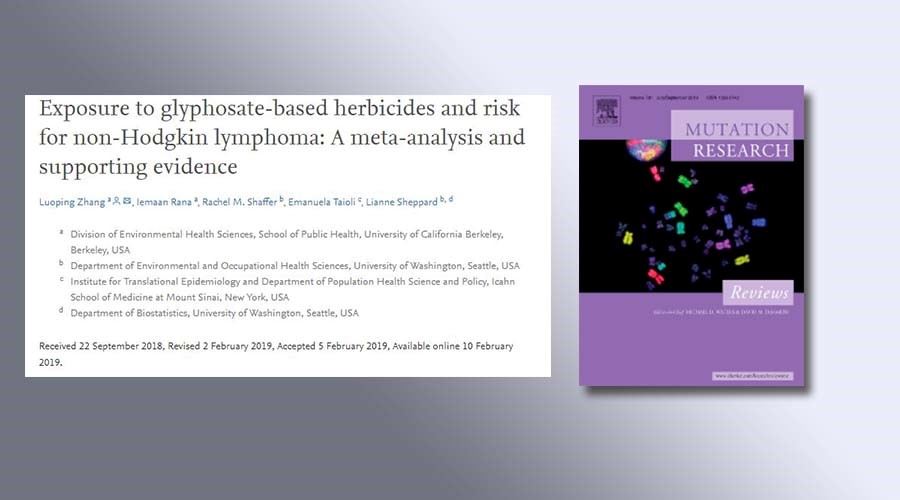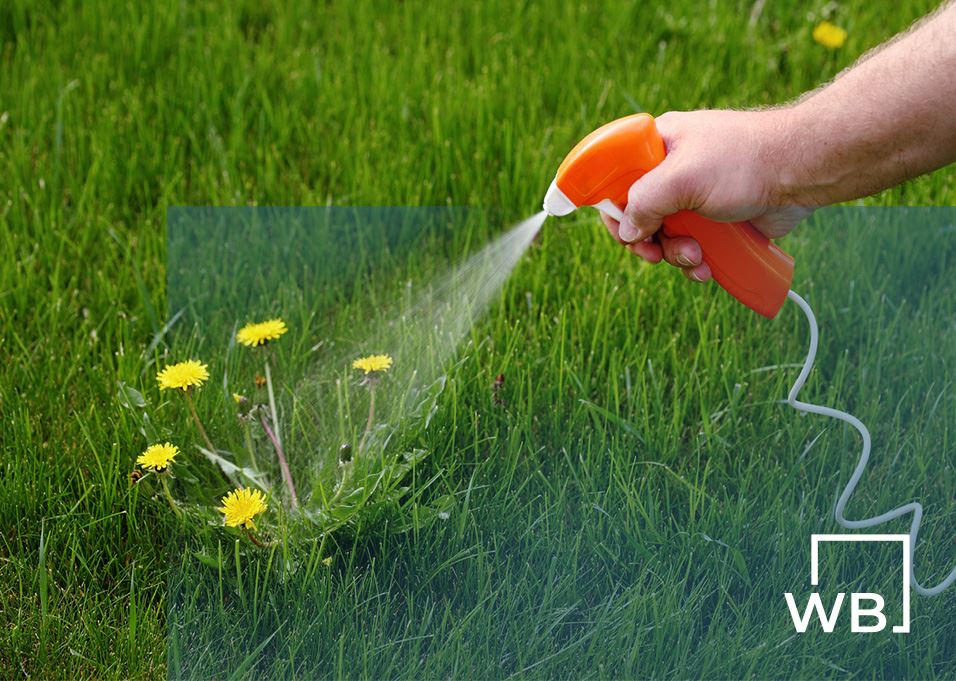
Researchers Find “Compelling Link” Between Roundup Exposure and Non-Hodgkin Lymphoma

 In this 2019 study, researchers at the University of California, Berkeley, University of Washington and the Icahn School of Medicine at Mount Sinai, New York, reported what they call a “compelling link” between exposure to a glyphosate-based herbicide (GBH) like Roundup and non-Hodgkin lymphoma.
In this 2019 study, researchers at the University of California, Berkeley, University of Washington and the Icahn School of Medicine at Mount Sinai, New York, reported what they call a “compelling link” between exposure to a glyphosate-based herbicide (GBH) like Roundup and non-Hodgkin lymphoma.
The scientists, led by Luoping Zhang of the UC Berkeley School of Public Health, combined data from several previous studies of GBH exposure in an analytical process known as meta-analysis. Meta-analysis increases the number of subjects being studied and thereby enhances the ability of the research to detect an effect that might otherwise remain hidden or unclear. The investigators concluded that exposure to a glyphosate-based herbicide increases the risk of non-Hodgkin lymphoma by 41%.
Zhang’s study was unique in that she and her colleagues focused on individuals in each study who were reported to have had the highest exposure to GBHs. Higher and longer exposures, they reasoned, would be more likely to reveal the true risk of GBH-associated NHL.
This is particularly true, they noted, in a world where most people have been exposed to glyphosate directly or indirectly. The reason is relatively simple: to determine if a substance has negative health consequences, scientists need to compare those exposed to the substance with a control group of individuals not exposed. But where do you find that control group if everyone is exposed?
The AHS was a cohort study. In cohort studies, individuals exposed to a substance thought to increase disease risk and a related group of people not exposed to the risk factor are followed for a defined period of time. Researchers then determine if the incidence of the disease was greater in the exposed group.
In the AHS, the exposed group consisted of licensed pesticide applicators who were enrolled in the study from 1993 – 1997. A 2005 study based on the AHS results found no statistically significant link between glyphosate exposure. A second study published in 2018, which followed some subjects up to 2013, also reported no link between glyphosate-based herbicide and cancer. Indeed, the second study suggested that GBHs decreased the risk of NHL.
However, several well-respected scientists—including scientists at Monsanto and one of the authors of the original 2005 AHS study (Aaron Blair, who worked for the National Cancer Institute at the time)—said the AHS study was fundamentally flawed due to non-differential exposure misclassification. Non-differential exposure misclassification occurs when individuals who have been exposed to the toxin being studied, in this case GBHs, are misclassified as non-exposed – or the reverse, non-exposed subjects being classified as exposed. Those who acquire the disease being studied and those who do not may both be misclassified. Non-differential exposure misclassification will bias the results of a study in the direction of no effect. It will appear that there is no association, even if one exists. In her testimony during the Pilliod trial, Dr. Beate Ritz, chair of the Department of Epidemiology at UCLA, provided detailed analysis of the problems with the Agricultural Health Study (beginning on pdf p. 100 of the Day 5 transcript.)
The Zhang study, by combining data from multiple studies, including the AHS, but focusing on the high-exposure groups, revealed the association that was obscured by the exposure misclassification of the AHS study.
Zhang’s results are supported by a new French study, published in March 2019 in the International Journal of Epidemiology. This study of multiple pesticides (herbicides like Roundup are categorized within the pesticide group) pooled data from three large cohort studies of agricultural workers, the AHS and two other studies, one in France and one in Norway. The authors of this study did not attempt to identify different levels of exposure. Exposure was categorized as either exposed or never exposed. In addition, pesticide use among the Norwegian and French cohorts (63% and 68 % respectively) was much lower than the AHS cohort (99%). Nevertheless, while not finding an association between glyphosate and NHL, authors report a statistically significant association between any exposure to glyphosate and risk for the most common type of NHL— diffuse large B-cell lymphoma (DLBCL). Glyphosate increased the risk by 36%. Out of 14 pesticides and 33 active ingredients analyzed by the French investigators, glyphosate was the only one to show a statistically significant association with diffuse large B-cell lymphoma.
The Zhang study also reviewed the results of animal studies and mechanistic studies. Four of six studies of malignant lymphomas in mice reported statistically significant associations with glyphosate exposure. The authors note that the mice in these studies were not exposed to the full glyphosate-based herbicide, which includes additives that have been reported to make the full formulation more toxic than simple glyphosate. Zhang discusses several mechanisms that are believed to be the means by which GBHs exert their carcinogenic effects. These include suppression of the immune system, disruption of the endocrine system, genetic alterations (DNA damage), and oxidative stress.
“Generally speaking, these mechanisms, among others, provide evidence of biological plausibility for the observed link between glyphosate exposure and human NHL, though further work is needed to better understand these factors.” — Lupoing Zhang & colleagues, 2019 meta-analysis.
It is noteworthy that Zhang and two other members of her team, Emanuela Taioli and Lianne Sheppard, served as Science Review Board Members for the US Environmental Protection Agency’s FIFRA (Federal Insecticide, Fungicide, and Rodenticide Act) Scientific Advisory Panel that evaluated glyphosate in December 2016.
Summary Information
Title
Exposure to glyphosate-based herbicides and risk for non-Hodgkin lymphoma: A meta-analysis and supporting evidence
Authors
Luoping Zhang1, Iemaan Rana1, Rachel M. Shaffer2, Emanuela Taioli3, Lianne Sheppard2,4
- Division of Environmental Health Sciences, School of Public Health, University of California Berkeley, Berkeley, USA.
- Department of Environmental and Occupational Health Sciences, University of Washington, USA.
- Institute for Translational Epidemiology and Department of Population Health Science and Policy, Icahn School of Medicine at Mount Sinai, New York, USA
- Department of Biostatistics, University of Washington, Seattle, USA
Journal
Mutation Research-Reviews in Mutation Research 781 (2019), 186-206
Funding
R.M.S. was supported by National Institutes of Environmental Health Sciences (NIEHS) award T32ES015459 and the University of Washington Retirement Association Aging Fellowship.

OVER $4 billion
in verdicts & Settlements
Our top priority is to devise customized legal strategies that are tailored to the unique legal needs of our clients, no matter how simple or complicated their situations, might be.
-
$2.0 Billion Verdict Personal Injury
In May of 2019, the jury in the case of Pilliod et al. v, Monsanto Company ordered the agrochemical giant to pay $2.055 billion in damages to the plaintiffs, Alva and Alberta Pilliod, a Bay Area couple in their 70s.
-
$289.2 Million Verdict Personal Injury
On Aug. 10, 2018, a San Francisco jury ordered Monsanto to pay $39.25 million in compensatory damages and $250 million in punitive damages to Mr. Johnson, a former groundskeeper who alleged exposure to Monsanto’s herbicides caused him to develop terminal non-Hodgkin lymphoma.
-
$265 Million Settlement Fatal Train Crash
In 2016, Wisner Baum attorney Timothy A. Loranger and six other attorneys in the Plaintiffs’ Management Committee were able to secure a $265 million settlement for victims of the 2015 Amtrak 188 derailment in Philadelphia, one of the largest in the U.S. for 2016.
-
$105 Million Settlement Pharmaceutical Settlement
Wisner Baum obtained $105 million on behalf of multiple clients involved in a pharmaceutical negligence case.
-
$80 Million Verdict Personal Injury
Wisner Baum attorneys served on the trial team in the case of Hardeman v. Monsanto Company, which resulted in an $80 million jury verdict for the plaintiff, Edwin Hardeman.

Our Case Results

-
$265 Million Settlement Fatal Train Crash
In 2016, Wisner Baum attorney Timothy A. Loranger and six other attorneys in the Plaintiffs’ Management Committee were able to secure a $265 million settlement for victims of the 2015 Amtrak 188 derailment in Philadelphia, one of the largest in the U.S. for 2016.
-
$14 Million Settlement A Major US Plane Crash
Wisner Baum obtained a $14 million settlement for the death of a passenger in a major US plane crash.
-
$12 Million Settlement Helicopter Crash
Wisner Baum secured a $12 million settlement for a passenger who was injured in a helicopter crash.
-
$10 Million Settlement A Major Foreign Plane Crash
Wisner Baum obtained a $10 million settlement for the death of a passenger in a major foreign plane crash.
-
$2.0 Billion Verdict Personal Injury
In May of 2019, the jury in the case of Pilliod et al. v, Monsanto Company ordered the agrochemical giant to pay $2.055 billion in damages to the plaintiffs, Alva and Alberta Pilliod, a Bay Area couple in their 70s.
-
$80 Million Verdict Personal Injury
Wisner Baum attorneys served on the trial team in the case of Hardeman v. Monsanto Company, which resulted in an $80 million jury verdict for the plaintiff, Edwin Hardeman.

Client-Focused Representation
REVIEWS & TESTIMONIALS
We believe our track record speaks for itself. But you don’t have to take our word for it. See what our clients have to say about working with us.
-
"I Can’t Imagine a Better Law Firm"
Multiple lawyers recommended Wisner Baum to me and I have been consistently impressed with the quality of their work.
- Best Law Firms Survey -
"They Are About Changing the Systems..."
Wisner Baum are not only amazing attorneys but more importantly, they are activists. They are about changing the systems which got us into trouble in the first place. They understand their role in the process of making change.
- Kim Witczak -
"Top Legal Minds in the Country"
The Wisner Baum firm has some of the top legal minds in the country; they are driven, determined, trustworthy, ethical and passionate.
- From Best Lawyers® Best Law Firms





.2110081511550.png)